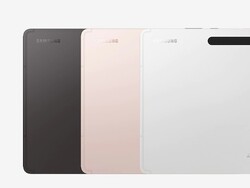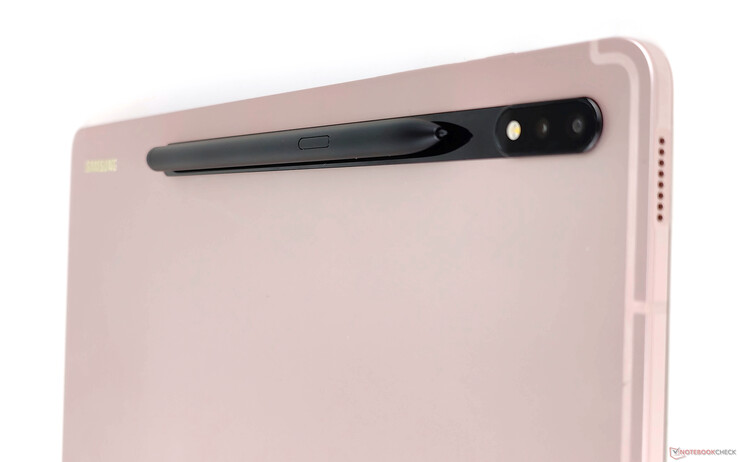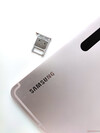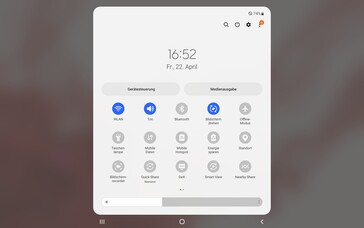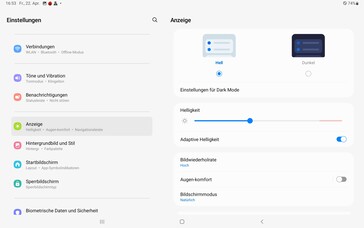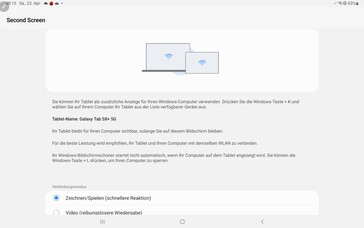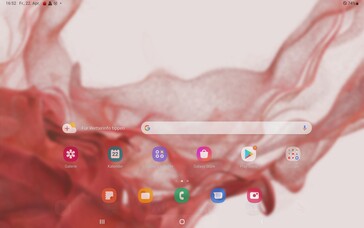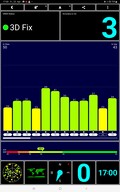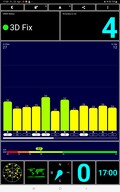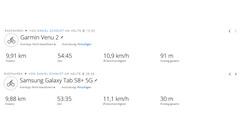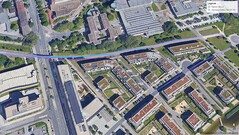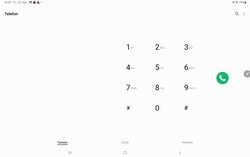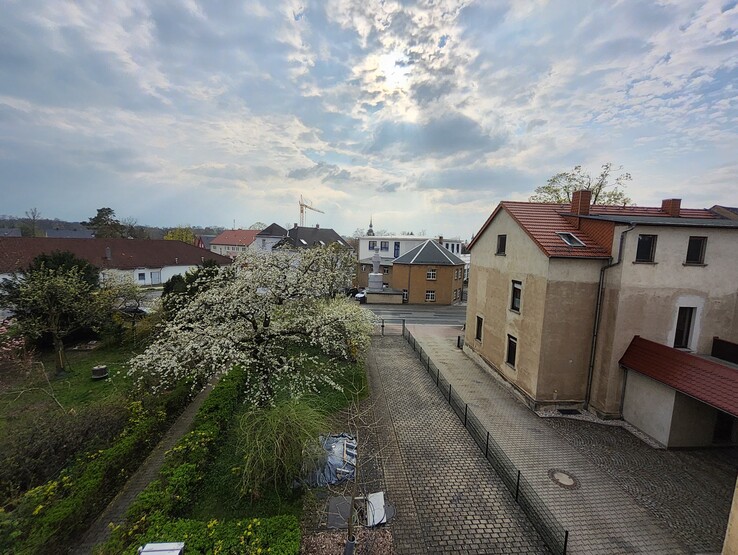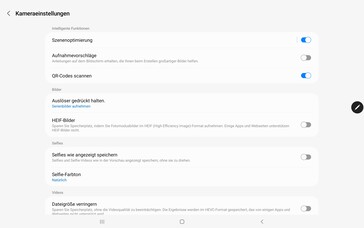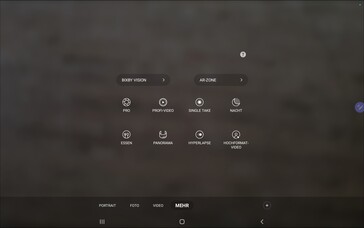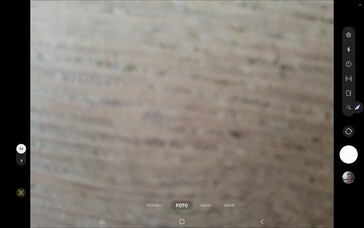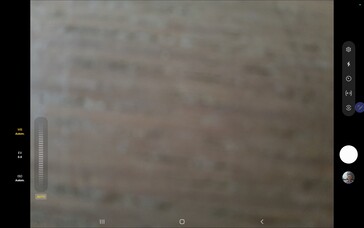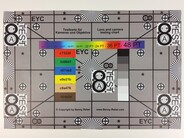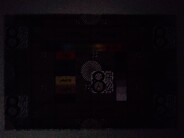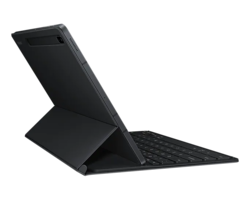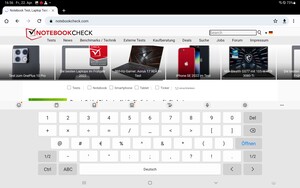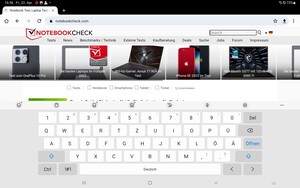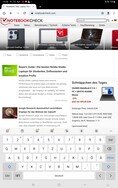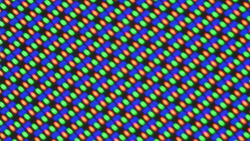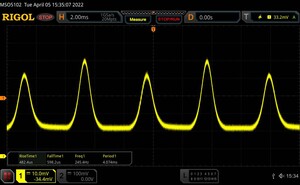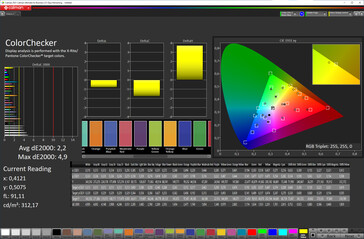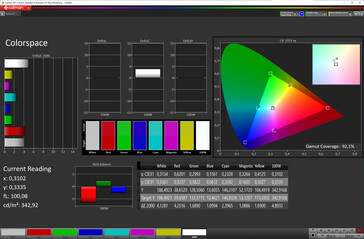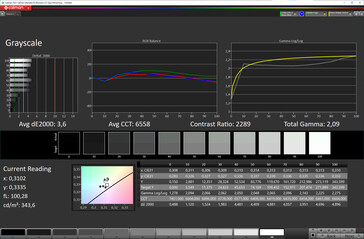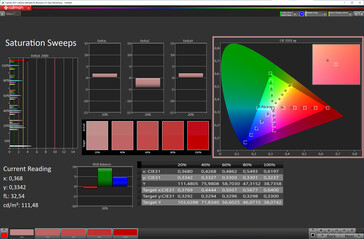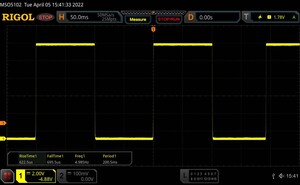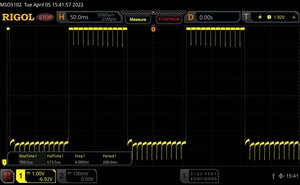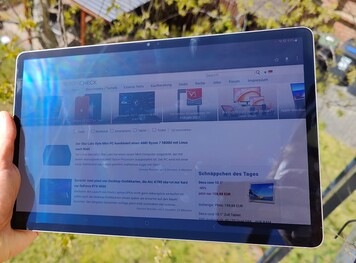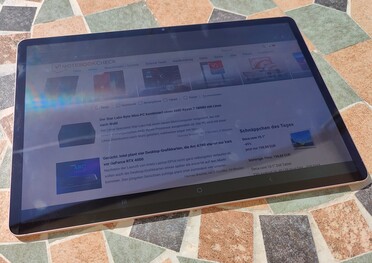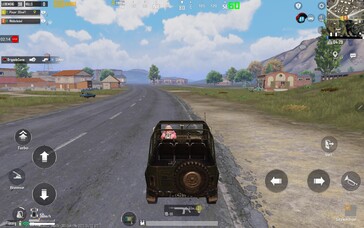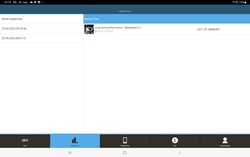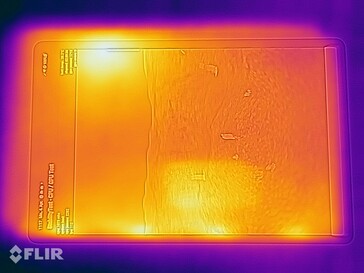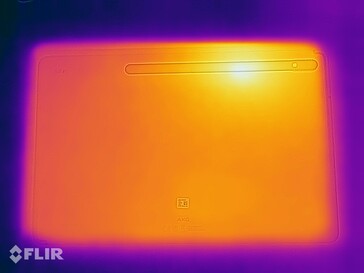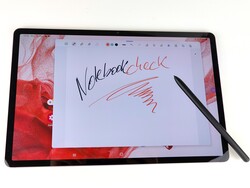三星Galaxy Tab S8+(Plus):5G平板电脑,配备大型OLED显示屏和5年的更新。
就像去年一样,今年的 "普通"Test Samsung Galaxy Tab S8 5G - Maximale Performance im 11-Zoll-FormatGalaxy Tab S8伴随着一个更大的12.4英寸的Plus型号,采用超级AMOLED显示屏,承诺比11英寸型号的IPS显示屏的黑电平和响应时间低得多。它的原始分辨率为2800 x 1752,刷新率为120 Hz,与Samsung Galaxy Tab S7 Plus Review - Finally a great Android tablet Galaxy Tab S7 Plus相同。根据不同的型号,你可以得到128或256GB的内部存储。
| Galaxy Tab S8+ 128 GB Wi-Fi $899 |
|---|
| Tab S8+ 128 GB 5G 目前在北美地区尚未上市。 |
| Tab S8+ 256 GB Wi-Fi $979 |
| Tab S8+ 256 GB 5G 目前在北美地区还没有供应。 |
» Notebookcheck多媒体笔记本电脑Top 10排名
» Notebookcheck游戏笔记本电脑Top 10排名
» Notebookcheck低价办公/商务笔记本电脑Top 10排名
» Notebookcheck高端办公/商务笔记本电脑Top 10排名
» Notebookcheck工作站笔记本电脑Top 10排名
» Notebookcheck亚笔记本电脑Top 10排名
» Notebookcheck超级本产品Top 10排名
» Notebookcheck变形本产品Top 10排名
» Notebookcheck平板电脑Top 10排名
» Notebookcheck智能手机Top 10排名
» Notebookcheck评测过最出色的笔记本电脑屏幕
» Notebookcheck售价500欧元以下笔记本电脑Top 10排名
» Notebookcheck售价300欧元以下笔记本电脑Top 10排名
SoC是由高通公司提供的,是Snapdragon 8 Gen1。像以前一样,它只有8GB的内存。在后部,我们发现一个1300万像素的主传感器,以及一个500万像素的超广角镜头。
潜在的竞争对手比较
Rating | Date | Model | Weight | Height | Size | Resolution | Price |
|---|---|---|---|---|---|---|---|
| 88.3 % v7 (old) | 04 / 2022 | Samsung Galaxy Tab S8+ 5G SD 8 Gen 1, Adreno 730 | 572 g | 5.7 mm | 12.40" | 2800x1752 | |
| 88.1 % v7 (old) | 08 / 2020 | Samsung Galaxy Tab S7 Plus SD 865+ (Plus), Adreno 650 | 575 g | 5.7 mm | 12.40" | 2800x1752 | |
| 89.1 % v7 (old) | 04 / 2022 | Lenovo Tab P12 Pro SD 870, Adreno 650 | 565 g | 5.6 mm | 12.60" | 2560x1600 | |
| 88.8 % v7 (old) | 10 / 2021 | Huawei MatePad Pro 12.6 2021 Kirin 9000E, Mali-G78 MP22 | 609 g | 6.7 mm | 12.60" | 2560x1600 | |
| 86.2 % v7 (old) | 09 / 2021 | Lenovo Yoga Tab 13 SD 870, Adreno 650 | 830 g | 6.2 mm | 13.00" | 2160x1350 | |
| 91.3 % v7 (old) | 06 / 2021 | Apple iPad Pro 12.9 2021 A2378 M1, M1 8-Core GPU | 682 g | 6.4 mm | 12.90" | 2732x2048 |
外壳 - 5G平板电脑无凹槽
由于其非常大的12.4英寸OLED显示屏,Galaxy Tab S8 Plus不能用一只手舒适地握住。然而,它不到6毫米,非常薄,重量超过100克(3.5盎司),比iPad Pro 12.9,也比其 它的重量比它的直接前辈更轻.除了侧面的按钮和SIM卡托盘外,所有的金属部件都是由三星的新合金制成的,被称为 "铠甲铝"。它不仅保证了低重量,而且还提高了抗划伤能力,减少了弯曲。
在Galaxy Tab S8 Plus的正面,我们发现了大猩猩玻璃Victus+,该外壳有三种不同的颜色。由于它的磨砂涂层,它主要是防指纹的,而且它留下了一个很好的视觉和触觉印象。物理按钮提供了一个非常好的强调点,并牢牢地坐在各自的腔体中。另一方面,由于该平板电脑的方形和边缘设计以及金属框架和后部之间的明显过渡,人体工程学并不理想。
附带的S笔可以用磁力吸附在外壳的顶部以及背面。后面的磁条由高光泽的大猩猩玻璃Victus+覆盖,在连接时可以为S笔无线充电。不幸的是,S8 Plus没有经过IP认证,无法防止灰尘和水的侵入。
连接性 - 三星Galaxy Tab S8 Plus没有3.5毫米耳机插孔
正如这个价格范围内的平板电脑所预期的那样,Galaxy Tab S8 Plus具有各种有趣的连接功能,为其固有的专业使用性质增加了真正的多媒体专业知识。例如,AKG制造的四扬声器阵列,光学指纹识别器,以及支持最大1TB的microSD卡,包括支持exFAT文件系统,由于该系统,你可以在microSD卡上保存大于4GB的文件。
在生产力方面,Galaxy Tab S8 Plus具有用于磁性连接的三星书套键盘的常规连接器,以及一个传输速度高达5Gbit/s的USB 3.2 Gen 1端口。它还支持有线显示输出,以连接到外部显示器,以及通过Miracast进行无线显示输出。
除此以外,Galaxy Tab S8 Plus还可以作为辅助屏幕使用。它需要一台至少运行Windows 10的Windows电脑,并支持两种不同的输出模式,绘图/游戏和视频。
微型SD卡读卡器
当用我们的Angelbird V60参考卡进行基准测试时,Galaxy Tab S8 Plus的microSD读卡器提供了足够的性能。它可能没有华为MatePad Pro 12.6的速度快,但54MB/s的速度还是比较合适的。CPCT性能也是足够的。
| SD Card Reader - average JPG Copy Test (av. of 3 runs) | |
| Huawei MatePad Pro 12.6 2021 (Huawei NanoMemory) | |
| Samsung Galaxy Tab S8+ 5G (Angelbird AV Pro V60) | |
| Lenovo Tab P12 Pro (Angelbird V60) | |
Cross Platform Disk Test (CPDT)
软件 - 三星平板电脑与Android 12
除了硬件升级外,三星还在软件支持方面加大了力度。Galaxy Tab S8系列平板电脑将获得多达四个主要的Android ,以及长达五年的安全更新。没有其他Android 平板电脑制造商能提供类似的东西。
作为三星的典型,该操作系统配备了三星自己的One UI 4.1用户界面,包括三星的Bixby助手。在撰写本文时,我们的平板电脑正在运行Android 12,截至2022年3月的安全补丁。三星还提供了一个名为Knows Vault平台的功能,由一个安全芯片组成,以保护和隔离敏感数据,如密码或生物识别信息,并将其与主操作系统隔离。
结合三星的DeX界面,Galaxy Tab S8 Plus支持透明应用窗口和外部显示器的显示镜像。此外,三星自己的智能切换功能使用户可以访问其他至少运行One UI 3.1的三星Galaxy 设备上的数据。
通信和GNSS -Galaxy Tab S8+ with Wi-Fi 6E
Galaxy Android Tab S8 Plus是首批支持Wi-Fi 6E的平板电脑之一,利用6GHz频段进行Wi-Fi传输。此外,该平板电脑还支持三星的多用户MIMO,确保了非常高和相对稳定的数据速率。当连接到我们的华硕ROG Rapture GT-AXE11000路由器时, Tab S8 Plus实现了超过1800Mbps的传输速度。当连接到使用2.4和5GHz频段的普通Wi-Fi 6路由器时,它仍然能够实现非常高的数据传输速率,平均超过800Mbps。Galaxy
我们的评测单元配备了可选的骁龙X65 5G调制解调器和蓝牙5.2,它支持5G频率,以及总共19个LTE频段。像联想Tab P12 Pro,它很可能具有NFC芯片,但不支持无线支付系统。相反,NFC芯片被用于充电和连接三星S Pen。
| Networking | |
| iperf3 transmit AX12 | |
| Huawei MatePad Pro 12.6 2021 | |
| Lenovo Yoga Tab 13 | |
| Apple iPad Pro 12.9 2021 A2378 | |
| Samsung Galaxy Tab S7 Plus | |
| iperf3 receive AX12 | |
| Huawei MatePad Pro 12.6 2021 | |
| Lenovo Yoga Tab 13 | |
| Apple iPad Pro 12.9 2021 A2378 | |
| Samsung Galaxy Tab S7 Plus | |
| iperf3 receive AXE11000 | |
| Samsung Galaxy Tab S8+ 5G | |
| Lenovo Tab P12 Pro | |
| iperf3 transmit AXE11000 | |
| Samsung Galaxy Tab S8+ 5G | |
| Lenovo Tab P12 Pro | |
| iperf3 transmit AXE11000 6GHz | |
| Samsung Galaxy Tab S8+ 5G | |
| iperf3 receive AXE11000 6GHz | |
| Samsung Galaxy Tab S8+ 5G | |
电话和通话质量 - Tab S8+支持电话业务
摄像头--5G平板电脑的双摄像头阵列
与Samsung Galaxy Tab S7 Plus Review - Finally a great Android tabletGalaxy Tab S7 Plus不同的是,12.4英寸Galaxy Tab S8 Plus的前置摄像头比它的非Plus兄弟姐妹得到了小幅升级,配备了一个1200万像素的传感器,具有更宽的120度视野,类似于传统的超广角镜头。安装在显示屏上方的摄像头具有f/2.4的光圈,在明亮的日光下产生了超过可用的结果。尽管如此,人像模式下的虚化效果并不特别可靠,对焦也不是最好的。
在后部,三星的高端平板电脑采用了与前代产品相同的双摄像头阵列,一个1300万像素f/2.0的主摄像头和一个500万像素的辅助超广角镜头。主摄像头的色彩、细节和动态范围都非常好,对于社交媒体的帖子来说绰绰有余。在正常化和确定的条件下进行分析时,我们没有发现Delta E > 15的重大色彩偏差。
关于平板电脑是否需要后置摄像头的问题存在很大争议,但可以说,使用S8 Plus的广角镜头拍摄大型文件的照片效果完美无缺。除此之外,500万像素的镜头产生了大量的假象,整体清晰度很低,尤其是在边缘,细节往往模糊不清,完全消失。
主摄像头和前置摄像头都可以录制UHD质量的视频,最高可达30FPS。超广角镜头根本不支持4K视频录制。这款平板电脑支持在拍摄时切换摄像头,尽管该功能仅限于1300万像素的主摄像头和前置摄像头。
Image comparison
Choose a scene and navigate within the first image. One click changes the position on touchscreens. One click on the zoomed-in image opens the original in a new window. The first image shows the scaled photograph of the test device.
WeitwinkelWeitwinkelLow Light5x-ZoomUltraweitwinkel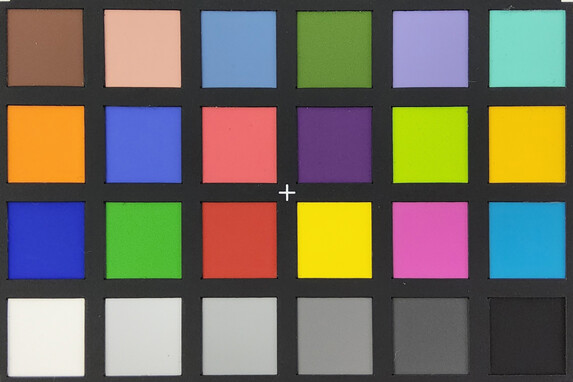
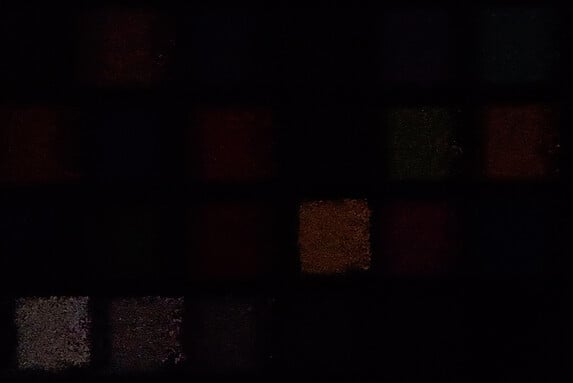
附件和保修 - 三星Galaxy Tab S8 Plus不含充电器
输入设备和处理 -Galaxy Tab S8+带指纹识别器
触摸输入在12.4英寸大猩猩玻璃Victus+覆盖的OLED显示屏上得到了非常快速和精确的注册。由于其120赫兹的高刷新率,滚动和One UI用户界面的动画非常流畅。8克(0.28盎司)的S Pen支持通常的4,096级压力敏感度,可以用Galaxy Tab S8 Plus进行手写笔记。它牢牢地、舒适地握在手中,我们发现即使是快速移动也几乎没有输入延迟。据三星称,输入延迟从Samsung Galaxy Tab S7 Plus Review - Finally a great Android tabletGalaxy Tab S7 Plus的9毫秒减少到新机型的不到2.8毫秒。慢速移动可以实现非常精确和直线的操作。该平板电脑支持手势输入,例如可以在图库应用中配置的S Pen动作。
光学指纹识别器位于OLED面板下方,工作可靠,但总体上有些昏昏欲睡。也支持利用平板电脑的前置摄像头,通过人脸识别来解锁设备。相对不安全的二维人脸识别功能的速度和可靠性都还不错。
显示屏 - 三星平板电脑与OLED
Galaxy Tab S8 Plus的16:10 OLED显示屏以2800 x 1572像素的原始分辨率运行,刷新率为120赫兹,据三星称,支持HDR10。然而,我们发现,在APL18测试中,均匀分布的黑暗和明亮表面的峰值亮度只有601尼特,因此不是特别高。因此,高对比度效果在Galaxy Tab S8 Plus的显示屏上有些缺乏。
当详细观察该面板时,我们发现它很可能与Tab S7 Plus's相同。纯白背景下的峰值亮度与去年的S7 Plus非常相似,也很平庸,新的显示屏只比Galaxy Tab S7 Plus的显示屏稍微亮一些。
正如OLED面板常见的那样,三星使用PWM来调节显示亮度。在33%及以下的亮度水平下,我们发现它的波动频率为120至245赫兹,在更高的亮度水平下,120赫兹左右的振幅更为均匀。由于这种低频率,敏感的用户可能会受到影响,几乎所有OLED面板都是如此。即使是Apple iPad Pro 12.9 2021 tablet review - A Mini LED trump card?Apple iPad Pro 12.9上的迷你LED显示屏也会在很高的频率下闪烁。
| |||||||||||||||||||||||||
Brightness Distribution: 97 %
Center on Battery: 459 cd/m²
Contrast: ∞:1 (Black: 0 cd/m²)
ΔE ColorChecker Calman: 2.2 | ∀{0.5-29.43 Ø4.77}
ΔE Greyscale Calman: 3.6 | ∀{0.09-98 Ø5}
92.1% sRGB (Calman 2D)
Gamma: 2.09
CCT: 6558 K
| Samsung Galaxy Tab S8+ 5G Super AMOLED, 2800x1752, 12.4" | Samsung Galaxy Tab S7 Plus Super AMOLED, 2800x1752, 12.4" | Lenovo Tab P12 Pro AMOLED, 2560x1600, 12.6" | Huawei MatePad Pro 12.6 2021 OLED, 2560x1600, 12.6" | Lenovo Yoga Tab 13 IPS, 2160x1350, 13" | Apple iPad Pro 12.9 2021 A2378 IPS mini-LED, 2732x2048, 12.9" | |
|---|---|---|---|---|---|---|
| Screen | 3% | -3% | 6% | -29% | 16% | |
| Brightness middle (cd/m²) | 459 | 441 -4% | 552 20% | 383 -17% | 404 -12% | 620 35% |
| Brightness (cd/m²) | 462 | 447 -3% | 555 20% | 390 -16% | 374 -19% | 612 32% |
| Brightness Distribution (%) | 97 | 98 1% | 97 0% | 94 -3% | 85 -12% | 96 -1% |
| Black Level * (cd/m²) | 0.4 | |||||
| Colorchecker dE 2000 * | 2.2 | 2.4 -9% | 3.43 -56% | 2.1 5% | 2.94 -34% | 1.8 18% |
| Colorchecker dE 2000 max. * | 4.9 | 4.1 16% | 7.25 -48% | 3.7 24% | 8.74 -78% | 4.9 -0% |
| Greyscale dE 2000 * | 3.6 | 2.9 19% | 2 44% | 2.1 42% | 4.3 -19% | 3.1 14% |
| Gamma | 2.09 105% | 2.01 109% | 2.253 98% | 2.14 103% | 2.14 103% | 2214 0% |
| CCT | 6558 99% | 6469 100% | 6417 101% | 6258 104% | 7084 92% | 6892 94% |
| Contrast (:1) | 1010 |
* ... smaller is better
Screen Flickering / PWM (Pulse-Width Modulation)
| Screen flickering / PWM detected | 245.4 Hz | ||
The display backlight flickers at 245.4 Hz (worst case, e.g., utilizing PWM) . The frequency of 245.4 Hz is relatively low, so sensitive users will likely notice flickering and experience eyestrain at the stated brightness setting and below. In comparison: 53 % of all tested devices do not use PWM to dim the display. If PWM was detected, an average of 8088 (minimum: 5 - maximum: 343500) Hz was measured. | |||
具有各种亮度设置的固定变焦
Display Response Times
| ↔ Response Time Black to White | ||
|---|---|---|
| 1.318 ms ... rise ↗ and fall ↘ combined | ↗ 0.6225 ms rise | |
| ↘ 0.6955 ms fall | ||
| The screen shows very fast response rates in our tests and should be very well suited for fast-paced gaming. In comparison, all tested devices range from 0.1 (minimum) to 240 (maximum) ms. » 6 % of all devices are better. This means that the measured response time is better than the average of all tested devices (20.2 ms). | ||
| ↔ Response Time 50% Grey to 80% Grey | ||
| 1.383 ms ... rise ↗ and fall ↘ combined | ↗ 0.7095 ms rise | |
| ↘ 0.6735 ms fall | ||
| The screen shows very fast response rates in our tests and should be very well suited for fast-paced gaming. In comparison, all tested devices range from 0.165 (minimum) to 636 (maximum) ms. » 5 % of all devices are better. This means that the measured response time is better than the average of all tested devices (31.6 ms). | ||
性能 - 三星Galaxy Tab S8 Plus,配备高通SoC
三星为Tab S8 系列选择的处理器是高通公司的顶级移动SoC,即Snapdragon 8 Gen. 1,这是一款基于ARM v9架构的4纳米SoC。其Kyro CPU由三个CPU集群组成,一个Prime核心(Cortex X2)、三个性能核心(Cortex A710)和四个效率核心(Cortex A510)。图形由一个集成的Adreno 730 处理。
在日常使用中,这款平板电脑给人留下了相当好的印象,我们在审查期间没有遇到任何重大滞后。然而,我们发现无法理解为什么三星为其旗舰平板电脑配备了不超过8GB的内存。如果有12GB的选择,那就绝对是必须的。应用程序的加载时间很短,尽管我们希望在处理小块数据时有一个性能更好的UFS 3.1存储。
Galaxy Tab S8 Plus的表现优于其 前代产品在我们的CPU基准测试中,它采用了过去的SoC,有很大的优势。这也解释了Galaxy Tab S8 Plus和基于骁龙870 的联想平板电脑之间在Geekbench结果中的相对较大差距。后者是基于与Qualcomm Snapdragon SD 865+ (Plus) 笔记本处理器 骁龙865 Plus相同的架构 。
| AImark - Score v2.x | |
| Lenovo Yoga Tab 13 | |
| Lenovo Tab P12 Pro | |
| Average Qualcomm Snapdragon 8 Gen 1 (1046 - 96317, n=14) | |
| Samsung Galaxy Tab S8+ 5G | |
| Apple iPad Pro 12.9 2021 A2378 | |
Galaxy Tab S8 Plus的Snapdragon 8 Gen.1在我们以GPU为基础的基准测试中表现得更加出色,这要归功于其集成的Adreno 730,它的表现超过了其前辈的Adreno 650高达60%。在3DMark Wild Life测试中,它几乎摧毁了它的前辈,性能超过了它的两倍。
GFXBench (DX / GLBenchmark) 2.7: T-Rex Onscreen | 1920x1080 T-Rex Offscreen
GFXBench 3.0: on screen Manhattan Onscreen OGL | 1920x1080 1080p Manhattan Offscreen
GFXBench 3.1: on screen Manhattan ES 3.1 Onscreen | 1920x1080 Manhattan ES 3.1 Offscreen
GFXBench: on screen Car Chase Onscreen | 1920x1080 Car Chase Offscreen | on screen Aztec Ruins High Tier Onscreen | 2560x1440 Aztec Ruins High Tier Offscreen | on screen Aztec Ruins Normal Tier Onscreen | 1920x1080 Aztec Ruins Normal Tier Offscreen
| 3DMark / Wild Life Extreme Unlimited | |
| Apple iPad Pro 12.9 2021 A2378 | |
| Samsung Galaxy Tab S8+ 5G | |
| Huawei MatePad Pro 12.6 2021 | |
| Lenovo Tab P12 Pro | |
| Lenovo Yoga Tab 13 | |
| 3DMark / Wild Life Extreme | |
| Apple iPad Pro 12.9 2021 A2378 | |
| Samsung Galaxy Tab S8+ 5G | |
| Huawei MatePad Pro 12.6 2021 | |
| Lenovo Tab P12 Pro | |
| Lenovo Yoga Tab 13 | |
| 3DMark / Wild Life Unlimited Score | |
| Apple iPad Pro 12.9 2021 A2378 | |
| Samsung Galaxy Tab S8+ 5G | |
| Huawei MatePad Pro 12.6 2021 | |
| Lenovo Tab P12 Pro | |
| Lenovo Yoga Tab 13 | |
| 3DMark / Wild Life Score | |
| Apple iPad Pro 12.9 2021 A2378 | |
| Samsung Galaxy Tab S8+ 5G | |
| Huawei MatePad Pro 12.6 2021 | |
| Lenovo Tab P12 Pro | |
| Lenovo Yoga Tab 13 | |
| GFXBench (DX / GLBenchmark) 2.7 / T-Rex Onscreen | |
| Apple iPad Pro 12.9 2021 A2378 | |
| Lenovo Tab P12 Pro | |
| Samsung Galaxy Tab S8+ 5G | |
| Samsung Galaxy Tab S7 Plus | |
| Huawei MatePad Pro 12.6 2021 | |
| Lenovo Yoga Tab 13 | |
| GFXBench (DX / GLBenchmark) 2.7 / T-Rex Offscreen | |
| Apple iPad Pro 12.9 2021 A2378 | |
| Samsung Galaxy Tab S8+ 5G | |
| Huawei MatePad Pro 12.6 2021 | |
| Lenovo Tab P12 Pro | |
| Lenovo Yoga Tab 13 | |
| Samsung Galaxy Tab S7 Plus | |
| GFXBench 3.0 / Manhattan Onscreen OGL | |
| Apple iPad Pro 12.9 2021 A2378 | |
| Samsung Galaxy Tab S8+ 5G | |
| Lenovo Tab P12 Pro | |
| Samsung Galaxy Tab S7 Plus | |
| Huawei MatePad Pro 12.6 2021 | |
| Lenovo Yoga Tab 13 | |
| GFXBench 3.0 / 1080p Manhattan Offscreen | |
| Apple iPad Pro 12.9 2021 A2378 | |
| Samsung Galaxy Tab S8+ 5G | |
| Huawei MatePad Pro 12.6 2021 | |
| Lenovo Tab P12 Pro | |
| Lenovo Yoga Tab 13 | |
| Samsung Galaxy Tab S7 Plus | |
| GFXBench 3.1 / Manhattan ES 3.1 Onscreen | |
| Apple iPad Pro 12.9 2021 A2378 | |
| Lenovo Yoga Tab 13 | |
| Samsung Galaxy Tab S8+ 5G | |
| Huawei MatePad Pro 12.6 2021 | |
| Lenovo Tab P12 Pro | |
| Samsung Galaxy Tab S7 Plus | |
| GFXBench 3.1 / Manhattan ES 3.1 Offscreen | |
| Apple iPad Pro 12.9 2021 A2378 | |
| Samsung Galaxy Tab S8+ 5G | |
| Huawei MatePad Pro 12.6 2021 | |
| Lenovo Tab P12 Pro | |
| Lenovo Yoga Tab 13 | |
| Samsung Galaxy Tab S7 Plus | |
| GFXBench / Car Chase Onscreen | |
| Apple iPad Pro 12.9 2021 A2378 | |
| Samsung Galaxy Tab S8+ 5G | |
| Lenovo Yoga Tab 13 | |
| Huawei MatePad Pro 12.6 2021 | |
| Lenovo Tab P12 Pro | |
| Samsung Galaxy Tab S7 Plus | |
| GFXBench / Car Chase Offscreen | |
| Apple iPad Pro 12.9 2021 A2378 | |
| Samsung Galaxy Tab S8+ 5G | |
| Huawei MatePad Pro 12.6 2021 | |
| Lenovo Tab P12 Pro | |
| Lenovo Yoga Tab 13 | |
| Samsung Galaxy Tab S7 Plus | |
| GFXBench / Aztec Ruins High Tier Onscreen | |
| Apple iPad Pro 12.9 2021 A2378 | |
| Samsung Galaxy Tab S8+ 5G | |
| Huawei MatePad Pro 12.6 2021 | |
| Lenovo Yoga Tab 13 | |
| Lenovo Tab P12 Pro | |
| Samsung Galaxy Tab S7 Plus | |
| GFXBench / Aztec Ruins High Tier Offscreen | |
| Apple iPad Pro 12.9 2021 A2378 | |
| Samsung Galaxy Tab S8+ 5G | |
| Huawei MatePad Pro 12.6 2021 | |
| Samsung Galaxy Tab S7 Plus | |
| Lenovo Yoga Tab 13 | |
| Lenovo Tab P12 Pro | |
| GFXBench / Aztec Ruins Normal Tier Onscreen | |
| Apple iPad Pro 12.9 2021 A2378 | |
| Huawei MatePad Pro 12.6 2021 | |
| Samsung Galaxy Tab S8+ 5G | |
| Lenovo Yoga Tab 13 | |
| Lenovo Tab P12 Pro | |
| Samsung Galaxy Tab S7 Plus | |
| GFXBench / Aztec Ruins Normal Tier Offscreen | |
| Apple iPad Pro 12.9 2021 A2378 | |
| Samsung Galaxy Tab S8+ 5G | |
| Huawei MatePad Pro 12.6 2021 | |
| Lenovo Yoga Tab 13 | |
| Samsung Galaxy Tab S7 Plus | |
| Lenovo Tab P12 Pro | |
| Jetstream 2 - 2.0 Total Score | |
| Apple iPad Pro 12.9 2021 A2378 (Safari 14.1.1) | |
| Average of class Tablet (22.3 - 395, n=68, last 2 years) | |
| Lenovo Tab P12 Pro (Chrome 98) | |
| Average Qualcomm Snapdragon 8 Gen 1 (72.8 - 134.6, n=16) | |
| Samsung Galaxy Tab S8+ 5G (Samsung Browser V16) | |
| Lenovo Yoga Tab 13 (Chrome 92) | |
| Huawei MatePad Pro 12.6 2021 (Huawei Browser 11.1.4.302) | |
| Samsung Galaxy Tab S7 Plus (Samsung Browser 12.1) | |
| JetStream 1.1 - Total Score | |
| Apple iPad Pro 12.9 2021 A2378 | |
| Samsung Galaxy Tab S8+ 5G | |
| Samsung Galaxy Tab S8+ 5G | |
| Average Qualcomm Snapdragon 8 Gen 1 (121.9 - 237, n=11) | |
| Lenovo Tab P12 Pro (Chrome 98) | |
| Lenovo Yoga Tab 13 (Chrome 92) | |
| Samsung Galaxy Tab S7 Plus (Samsung Browser 12.1) | |
| Huawei MatePad Pro 12.6 2021 (Huawei Browser 11.1.4.302) | |
| WebXPRT 3 - Overall | |
| Average of class Tablet (39 - 480, n=24, last 2 years) | |
| Apple iPad Pro 12.9 2021 A2378 (Safari 14.1.1) | |
| Lenovo Tab P12 Pro (Chrome 98) | |
| Samsung Galaxy Tab S8+ 5G (Samsung Browser V16) | |
| Average Qualcomm Snapdragon 8 Gen 1 (79 - 193, n=15) | |
| Lenovo Yoga Tab 13 (Chrome 92) | |
| Samsung Galaxy Tab S7 Plus (Samsung Browser 12.1) | |
| Huawei MatePad Pro 12.6 2021 (Huawei Browser 11.1.4.302) | |
| Speedometer 2.0 - Result 2.0 | |
| Apple iPad Pro 12.9 2021 A2378 (Safari 14.1.1) | |
| Average of class Tablet (2.59 - 790, n=54, last 2 years) | |
| Average Qualcomm Snapdragon 8 Gen 1 (64.4 - 129.3, n=16) | |
| Samsung Galaxy Tab S8+ 5G (Samsung Browser V16) | |
| Lenovo Yoga Tab 13 (Chome 92) | |
| Huawei MatePad Pro 12.6 2021 (Huawei Browser 11.1.4.302) | |
| Samsung Galaxy Tab S7 Plus (Samsung Browser 12.1) | |
| Lenovo Tab P12 Pro (Chrome 98) | |
| Octane V2 - Total Score | |
| Apple iPad Pro 12.9 2021 A2378 (Safari 14.1.1) | |
| Average of class Tablet (763 - 138481, n=94, last 2 years) | |
| Average Qualcomm Snapdragon 8 Gen 1 (27730 - 50626, n=17) | |
| Samsung Galaxy Tab S8+ 5G (Samsung Browser V16) | |
| Lenovo Tab P12 Pro (Chrome 98) | |
| Lenovo Yoga Tab 13 (Chrome 92) | |
| Samsung Galaxy Tab S7 Plus (Samsung Browser 12.1) | |
| Huawei MatePad Pro 12.6 2021 (Huawei Browser 11.1.4.302) | |
| Mozilla Kraken 1.1 - Total | |
| Average of class Tablet (243 - 27101, n=79, last 2 years) | |
| Samsung Galaxy Tab S7 Plus (Samsung Browser 12.1) | |
| Huawei MatePad Pro 12.6 2021 (Huawei Browser 11.1.4.302) | |
| Lenovo Yoga Tab 13 (Chrome 92) | |
| Lenovo Tab P12 Pro (Chrome 98) | |
| Average Qualcomm Snapdragon 8 Gen 1 (814 - 1440, n=16) | |
| Samsung Galaxy Tab S8+ 5G (Samsung Browser V16) | |
| Apple iPad Pro 12.9 2021 A2378 (Safari 14.1.1) | |
* ... smaller is better
| Samsung Galaxy Tab S8+ 5G | Samsung Galaxy Tab S7 Plus | Lenovo Tab P12 Pro | Huawei MatePad Pro 12.6 2021 | Lenovo Yoga Tab 13 | Average 256 GB UFS 3.1 Flash | Average of class Tablet | |
|---|---|---|---|---|---|---|---|
| AndroBench 3-5 | -11% | -10% | 39% | -11% | 20% | 13% | |
| Sequential Read 256KB (MB/s) | 1726.34 | 1675 -3% | 1782 3% | 2031 18% | 1431 -17% | 1757 ? 2% | 1786 ? 3% |
| Sequential Write 256KB (MB/s) | 1374.65 | 732 -47% | 758 -45% | 1559 13% | 711 -48% | 1204 ? -12% | 1337 ? -3% |
| Random Read 4KB (MB/s) | 202.35 | 230.1 14% | 232.5 15% | 310 53% | 249.1 23% | 287 ? 42% | 246 ? 22% |
| Random Write 4KB (MB/s) | 218.02 | 205 -6% | 189.2 -13% | 369.7 70% | 215.2 -1% | 318 ? 46% | 279 ? 28% |
游戏 -Galaxy 平板电脑,116 FPS
我们使用GameBench,记录了Galaxy Tab S8 Plus在精选的Android 游戏中实现的精确每秒帧率。PUBG Mobile在UHD分辨率下以40 FPS的速度运行,并具有最大的细节。降低细节可以达到60FPS。
支持更高刷新率显示器的游戏,如Armajet,将在短时间内达到接近显示器理论最大值的帧率。我们在Galaxy Tab S8 Plus上记录的最高帧率为116 FPS。
排放--Galaxy Tab S8+保持冷静
温度
即使在持续的负载下,机箱仍然比较凉爽。运行GFXBench,我们评估了高通SoC在高GPU负载下的表现。而当Galaxy Tab S8 Plus成功完成OpenGL 3.1电池测试时,结果没有被记录下来。
我们还在Galaxy Tab S8 Plus上运行了3DMark的压力测试,就像Snapdragon 8 Gen. 1 配备的智能手机一样,Tab S8+的性能在一段时间内不稳定。
3DMark Wild Life Stress Test
(+) The maximum temperature on the upper side is 30.6 °C / 87 F, compared to the average of 33.6 °C / 92 F, ranging from 20.7 to 53.2 °C for the class Tablet.
(+) The bottom heats up to a maximum of 30.7 °C / 87 F, compared to the average of 33.2 °C / 92 F
(+) In idle usage, the average temperature for the upper side is 27.2 °C / 81 F, compared to the device average of 30 °C / 86 F.
发言人
Galaxy Tab S8 Plus总共有四个扬声器,由AKG优化。我们喜欢它们的整体质量,尽管低音表现相当弱。 然而,Tab S8 Plus的整体声景在中音和高音方面是线性的,其最大音量为88 dB(A),足够大。
一些用户肯定会怀念Galaxy Tab S8 Plus缺少的3.5毫米音频插孔,将不得不用USB-C加密狗来代替。不幸的是,三星并没有在包装盒中包括一个3.5毫米的加密狗,这意味着如果需要,必须单独购买。通过蓝牙5.2的无线音频输出支持SBC、AAC、aptX和LDAC。我们希望能有更广泛的无线音频编解码器的支持。
Samsung Galaxy Tab S8+ 5G audio analysis
(+) | speakers can play relatively loud (88.2 dB)
Bass 100 - 315 Hz
(-) | nearly no bass - on average 17.6% lower than median
(±) | linearity of bass is average (8.4% delta to prev. frequency)
Mids 400 - 2000 Hz
(+) | balanced mids - only 3.1% away from median
(+) | mids are linear (5% delta to prev. frequency)
Highs 2 - 16 kHz
(+) | balanced highs - only 2.8% away from median
(+) | highs are linear (4.6% delta to prev. frequency)
Overall 100 - 16.000 Hz
(+) | overall sound is linear (12.2% difference to median)
Compared to same class
» 18% of all tested devices in this class were better, 4% similar, 78% worse
» The best had a delta of 7%, average was 20%, worst was 129%
Compared to all devices tested
» 9% of all tested devices were better, 2% similar, 88% worse
» The best had a delta of 4%, average was 24%, worst was 134%
Samsung Galaxy Tab S7 Plus audio analysis
(+) | speakers can play relatively loud (87.2 dB)
Bass 100 - 315 Hz
(±) | reduced bass - on average 12.9% lower than median
(±) | linearity of bass is average (10.3% delta to prev. frequency)
Mids 400 - 2000 Hz
(+) | balanced mids - only 3.8% away from median
(+) | mids are linear (2.7% delta to prev. frequency)
Highs 2 - 16 kHz
(+) | balanced highs - only 2.9% away from median
(+) | highs are linear (5.5% delta to prev. frequency)
Overall 100 - 16.000 Hz
(+) | overall sound is linear (10.9% difference to median)
Compared to same class
» 11% of all tested devices in this class were better, 3% similar, 87% worse
» The best had a delta of 7%, average was 20%, worst was 129%
Compared to all devices tested
» 6% of all tested devices were better, 2% similar, 93% worse
» The best had a delta of 4%, average was 24%, worst was 134%
能源管理 - 三星Galaxy Tab S8+,配备10,090 mAh电池
消耗功率
据三星称,10,090毫安时的电池可以用45瓦充电。可选的45瓦电源可以在大约90分钟内将平板电脑从0充电到100%。
对于配备了Snapdragon 8 Gen. 1的平板电脑,我们发现其最大功耗处于可接受的水平。然而,它的空闲功耗还有待改进。
| Off / Standby | |
| Idle | |
| Load |
|
Key:
min: | |
| Samsung Galaxy Tab S8+ 5G 10090 mAh | Samsung Galaxy Tab S7 Plus 10090 mAh | Lenovo Tab P12 Pro 10200 mAh | Huawei MatePad Pro 12.6 2021 10050 mAh | Lenovo Yoga Tab 13 10000 mAh | Apple iPad Pro 12.9 2021 A2378 mAh | |
|---|---|---|---|---|---|---|
| Power Consumption | 10% | 13% | -85% | -13% | -73% | |
| Idle Minimum * (Watt) | 3.08 | 2.41 22% | 2.2 29% | 6.2 -101% | 3 3% | 1.8 42% |
| Idle Average * (Watt) | 3.69 | 3.4 8% | 2.6 30% | 9.07 -146% | 3.4 8% | 9.6 -160% |
| Idle Maximum * (Watt) | 3.76 | 3.43 9% | 3.2 15% | 9.12 -143% | 4.1 -9% | 9.8 -161% |
| Load Average * (Watt) | 7.72 | 6.63 14% | 7.1 8% | 8.79 -14% | 9.9 -28% | 12.2 -58% |
| Load Maximum * (Watt) | 9.87 | 10.29 -4% | 11.5 -17% | 12.07 -22% | 13.8 -40% | 12.6 -28% |
* ... smaller is better
Power Consumption: Geekbench (150 cd/m²)
Power Consumption: GFXBench (150 cd/m²)
电池寿命
与它的 前辈,Galaxy Tab S8 Plus的运行时间并不长。在我们的Wi-Fi测试中,显示亮度正常化为150尼特,在刷新率设置为120赫兹的情况下,平板电脑持续了约7小时。在我们禁用通信模块的视频播放测试中,12.4英寸的平板电脑只持续了10个小时。
它的大多数竞争对手,包括联想Tab P12 Pro,在外出时都会比三星平板电脑更耐用。有些,如,华为MatePad Pro 12.6 2021,甚至是2倍的系数。
| Samsung Galaxy Tab S8+ 5G 10090 mAh | Samsung Galaxy Tab S7 Plus 10090 mAh | Lenovo Tab P12 Pro 10200 mAh | Huawei MatePad Pro 12.6 2021 10050 mAh | Lenovo Yoga Tab 13 10000 mAh | Apple iPad Pro 12.9 2021 A2378 mAh | |
|---|---|---|---|---|---|---|
| Battery runtime | 5% | 22% | 88% | 109% | 24% | |
| Reader / Idle (h) | 14.1 | 15 6% | 17.2 22% | 34.7 146% | 42.3 200% | |
| H.264 (h) | 10.1 | 10.3 2% | 14.9 48% | 22.8 126% | 20 98% | 13.6 35% |
| WiFi v1.3 (h) | 7.3 | 7.1 -3% | 10.5 44% | 12.3 68% | 17.6 141% | 11.2 53% |
| Load (h) | 5.2 | 5.9 13% | 3.9 -25% | 5.7 10% | 5.1 -2% | 4.3 -17% |
Pros
Cons
评语 三星Galaxy Tab S8+
Galaxy Tab S8 Plus是去年Tab S7 Plus 的坚实演变,鉴于高端平板电脑领域的竞争稀少,韩国制造商做了最起码的工作,创造了2022年最好的Android 平板电脑。
Galaxy Tab S8 Plus的唯一真正竞争对手是稍便宜的联想Tab P12 Pro。如果你觉得Galaxy Tab S8 Plus的显示屏太暗,不适合在户外使用,或者它的电池寿命是个问题,那么联想平板电脑可以成为一个很好的选择。尽管如此,你需要记住,联想的Precision Pen 3不能与三星的S Pen提供的优秀手写笔体验相提并论。
说到可持续性,三星是唯一一家拥有五年长更新周期的Android 平板电脑OEM,这是我们迄今为止只习惯于从Apple 。
尽管有一些不必要的缺点,但Tab S8+作为一个整体是很难超越的。
不幸的是,三星错过了修复Tab S7 Plus"缺陷的机会,例如昏暗的面板或相对较短的电池寿命,这是因为相同大小的电池与相对低效的一代高通SoC相结合。至少,三星选择了高通"最强大的高端SoC,而不是去年的型号。
在美国以外的一些市场,MatePad 12.6 Pro,可以成为比Galaxy Tab S8 Plus更实惠的替代品。然而,它缺乏对谷歌服务和应用程序的支持,使它对大多数用户来说毫无用处。如果你不介意这个缺点,你可能想仔细看看我们对华为平板电脑的评论。
价格和可用性
在美国,三星Galaxy Tab S8 Plus起价为899美元,可通过通常的零售渠道购买,例如 亚马逊.
Samsung Galaxy Tab S8+ 5G
- 08/30/2022 v7 (old)
Marcus Herbrich





